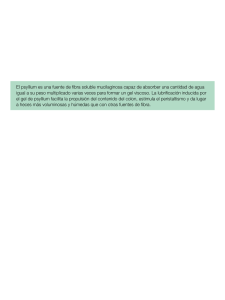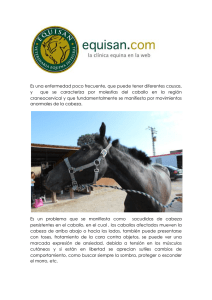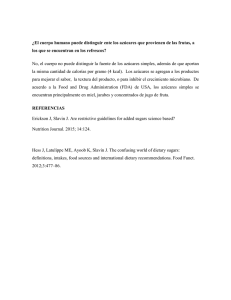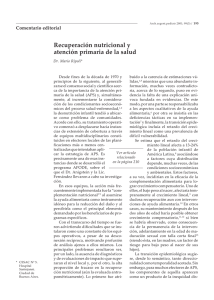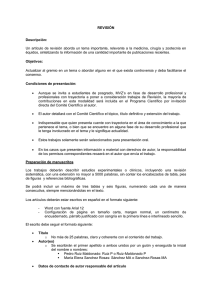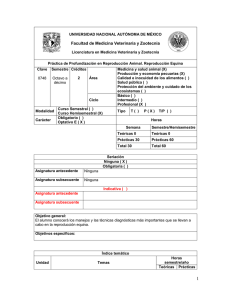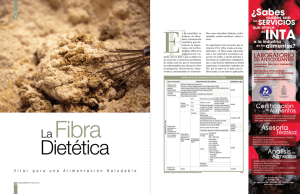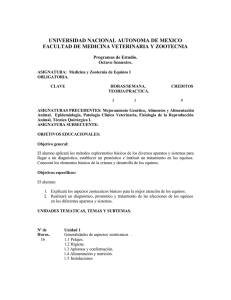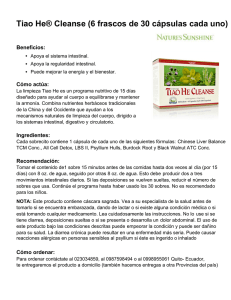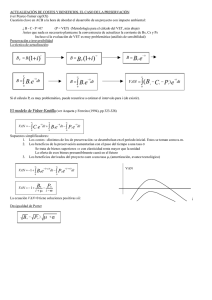Sand Control
Anuncio
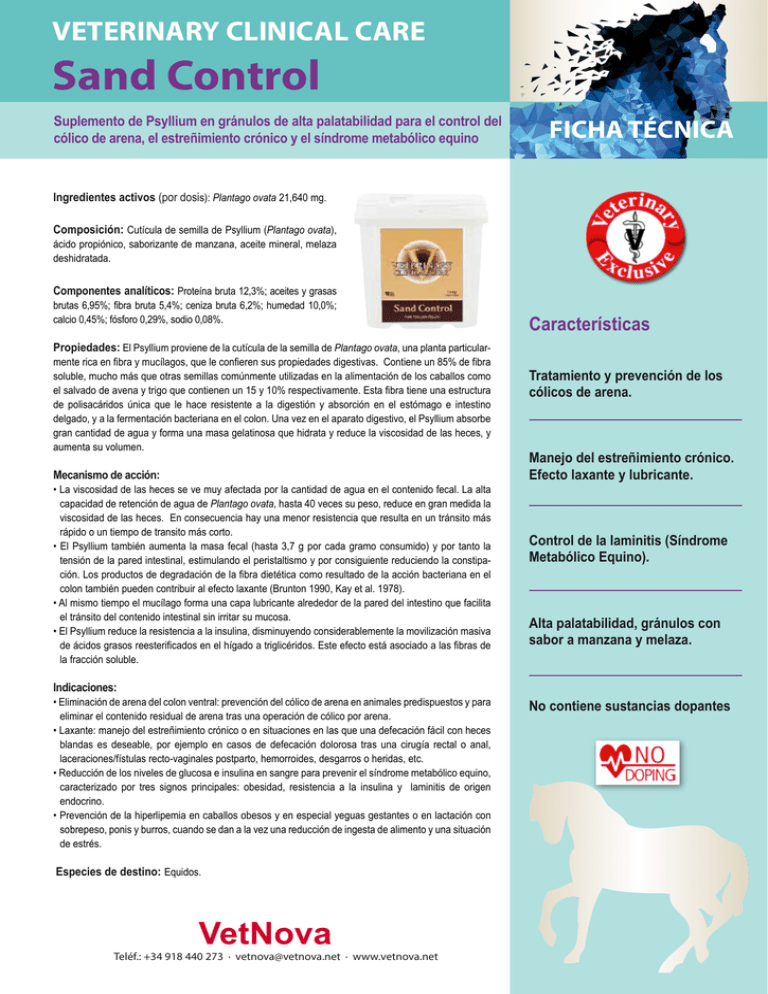
VETERINARY CLINICAL CARE Sand Control Suplemento de Psyllium en gránulos de alta palatabilidad para el control del cólico de arena, el estreñimiento crónico y el síndrome metabólico equino FICHA TÉCNICA Ingredientes activos (por dosis): Plantago ovata 21,640 mg. Composición: Cutícula de semilla de Psyllium (Plantago ovata), ácido propiónico, saborizante de manzana, aceite mineral, melaza deshidratada. Componentes analíticos: Proteína bruta 12,3%; aceites y grasas brutas 6,95%; fibra bruta 5,4%; ceniza bruta 6,2%; humedad 10,0%; calcio 0,45%; fósforo 0,29%, sodio 0,08%. Propiedades: El Psyllium proviene de la cutícula de la semilla de Plantago ovata, una planta particularmente rica en fibra y mucílagos, que le confieren sus propiedades digestivas. Contiene un 85% de fibra soluble, mucho más que otras semillas comúnmente utilizadas en la alimentación de los caballos como el salvado de avena y trigo que contienen un 15 y 10% respectivamente. Esta fibra tiene una estructura de polisacáridos única que le hace resistente a la digestión y absorción en el estómago e intestino delgado, y a la fermentación bacteriana en el colon. Una vez en el aparato digestivo, el Psyllium absorbe gran cantidad de agua y forma una masa gelatinosa que hidrata y reduce la viscosidad de las heces, y aumenta su volumen. Mecanismo de acción: • La viscosidad de las heces se ve muy afectada por la cantidad de agua en el contenido fecal. La alta capacidad de retención de agua de Plantago ovata, hasta 40 veces su peso, reduce en gran medida la viscosidad de las heces. En consecuencia hay una menor resistencia que resulta en un tránsito más rápido o un tiempo de transito más corto. • El Psyllium también aumenta la masa fecal (hasta 3,7 g por cada gramo consumido) y por tanto la tensión de la pared intestinal, estimulando el peristaltismo y por consiguiente reduciendo la constipación. Los productos de degradación de la fibra dietética como resultado de la acción bacteriana en el colon también pueden contribuir al efecto laxante (Brunton 1990, Kay et al. 1978). • Al mismo tiempo el mucílago forma una capa lubricante alrededor de la pared del intestino que facilita el tránsito del contenido intestinal sin irritar su mucosa. • El Psyllium reduce la resistencia a la insulina, disminuyendo considerablemente la movilización masiva de ácidos grasos reesterificados en el hígado a triglicéridos. Este efecto está asociado a las fibras de la fracción soluble. Indicaciones: • Eliminación de arena del colon ventral: prevención del cólico de arena en animales predispuestos y para eliminar el contenido residual de arena tras una operación de cólico por arena. • Laxante: manejo del estreñimiento crónico o en situaciones en las que una defecación fácil con heces blandas es deseable, por ejemplo en casos de defecación dolorosa tras una cirugía rectal o anal, laceraciones/fístulas recto-vaginales postparto, hemorroides, desgarros o heridas, etc. • Reducción de los niveles de glucosa e insulina en sangre para prevenir el síndrome metabólico equino, caracterizado por tres signos principales: obesidad, resistencia a la insulina y laminitis de origen endocrino. • Prevención de la hiperlipemia en caballos obesos y en especial yeguas gestantes o en lactación con sobrepeso, ponis y burros, cuando se dan a la vez una reducción de ingesta de alimento y una situación de estrés. Especies de destino: Equidos. Teléf.: +34 918 440 273 · vetnova@vetnova.net · www.vetnova.net Características Tratamiento y prevención de los cólicos de arena. Manejo del estreñimiento crónico. Efecto laxante y lubricante. Control de la laminitis (Síndrome Metabólico Equino). Alta palatabilidad, gránulos con sabor a manzana y melaza. No contiene sustancias dopantes VETERINARY CLINICAL CARE Sand Control Suplemento de Psyllium en gránulos de alta palatabilidad para el control del cólico de arena, el estreñimiento crónico y el síndrome metabólico equino Modo de empleo: • Prevención del cólico de arena en animales predispuestos o con historial de ingestión de arena, o como seguimiento post-quirúrgico de un cólico de arena (para eliminar la arena restante): 30 g por cada 100 kg de peso al día, durante 5 días seguidos cada mes. • Expulsión de grandes cantidades de arena (previo diagnóstico): 90 g por cada 100 kg de peso al día, durante 3-5 días. • Lubricante/laxante intestinal: 15 g por cada 100 kg de peso al día, hasta la desaparición del estreñimiento. La medida incluida, rasa, equivale a 30 gramos. Los animales deberán tener acceso permanente al agua. La cáscara de Plantago ovata actúa dentro de las 12 a 24 horas post-administración; a veces, el efecto máximo no se alcanza antes de 2 o 3 días. Presentación: 1,5 kg (50 dosis, 2 meses de suministro). Bibliografía: • Asplin KE, Sillence MN, Pollitt CC, McGowan CM. Induction of laminitis by prolonged hyperinsulinemia in clinically normal ponies. Vet J 2007;174:530-5. • Bach-Knudsen, K.E. The nutritional significance of “dietary fibre” analysis. Anim Feed Sci Technol 2001;90:3-20. • Biorklund, M.; Rees, A.; van Mensink, R.P.; Onning, G. Changes in serum lipids and postprandial glucose and insulin concentrations after consumption of beverages with beta-glucans from oats or barley: A randomized dose controlled trial. Eur. J. Clin. Nutr. 2005, 59, 1272–1281. • Bonnema, A.L.; Kohlberg, L.W.; Thomas, W.; Slavin, J.L. Gastrointestinal tolerance to chicory inulin products. J. Am. Diet. Assoc. 2010, 110, 865–868. • Brownawell, A.M.; Caers, W.; Gibson, G.R.; Kendall, C.W.C.; Lewis, K.D.; Ringel, Y.; Slavin, J.L. Prebiotics and the health benefits of fiber: Current regulatory status, future research, and goals. J. Nutr. 2012, 142, 1–13. • Calame, W.; Weseler, A.R.; Viebke, C.; Flynn, C.; Siemensma, A.D. Gum arabic establishes prebiotic functionality in healthy human volunteers in a dose-dependent manner. Br. J. Nutr. 2008, 100, 1269–1275. • Chaudhri, O.B.; Salem, V. Gastrointestinal satiety signals. Annu. Rev. Physiol. 2008, 70, 239–255. • Cinotti, S.; Gugllelmini, C.; Boari, A. The effect of psyllium on some haemotologic and biochemical variables in the plasma of horses during an endurance ride: preliminary results. Pferdeheilkunde 1997;13:23-6. • Costabile, A.; Kolida, S.; Klinder, A.; Gietl, E.; Bauerlein, M.; Frohburg, C.; Landschutze, V.; Gibson, G.R. A double-blind, placebo-controlled, cross-over study to establish the bifidogenic effect of a very-long chain inulin extracted from globe artichoke (Cynara scolymus) in healthy subjects. Br. J. Nutr. 2010, 104, 1007–1017. • Cummings, J.H. The Effect of Dietary Fiber on Fecal Weight and Composition. In CRC Handbook of Dietary Fiber in Human Nutrition; Spiller, G.A., Ed.; CRC Press: Boca Raton, FL, USA, 1993; pp. 263–333. • Cummings, J.H.; Macfarlane, G.T. The control and consequences of bacterial fermentation in the human colon. J. Appl. Bacteriol. 1991, 70, 443–459. • de Latt MA, McGowan CM, Sillence MN, Pollitt CC. Equine laminitis: induced by 48 h hyperinsulinemia in Standardbred horses. Equine Vet J 2010;42:129-35. • Dyer J, Merediz F, Salmon K, Proudman CJ, Edwards GB, Shirazi- Beechey SP. Molecular characterisation of carbohydrate digestion and absorption in equine small intestine. Equine Vet J 2002;34:349-58. • Eli, M.; Cattivelli, D.; Soldi, S.; Bonatti, M.; Morelli, L. Evaluation of prebiotic potential of refined psyllium (Plantago ovata) fiber in healthy women. J. Clin. Gastroenterol. 2008, 42, S174–S176. • Ellis AD, Hill J. Digestive physiology of the horse. In: Nutritional Physiology of the Horse. Nottingham, UK: Nottingham University Press; 2005. p. 34-7. • EMEA - Assessment report on Plantago ovata Forssk., seminis tegumentum , EMEA Report. 2013 • Fischer M, Yu N, Gray RG, Ralph J, Anderson L, Marlett JA. The gelforming polysaccharide of psyllium husk (Plantago ovata Forsk). Carbohydr Res 2004;339:2009-17. Teléf.: +34 918 440 273 · vetnova@vetnova.net · www.vetnova.net FICHA TÉCNICA VETERINARY CLINICAL CARE Sand Control Suplemento de Psyllium en gránulos de alta palatabilidad para el control del cólico de arena, el estreñimiento crónico y el síndrome metabólico equino • Frank, N, Geor RJ, Bailey SR, Durham AG, Johnson PG. Equine metabolic syndrome (ACVIM consensus statement). J Vet Int Med 2010;24:467-75. • Frank, N. Equine metabolic syndrome. J Equine Vet Sci 2009;29:259- 67. • Frank, N. Endocrinopathic laminitis, obesity-associated laminitis, and pasture-associated laminitis. Proceeding of the 54th Annual Convention of the American Association of Equine Practitioners; San Diego, CA, 2008:341-6. • Frank N, Elliot SB, Brandt LE, Keisler DH. Physical characteristics, blood hormone concentrations and plasma lipid concentrations in obese horses with insulin resistance. J Am Vet Med Assoc 2006;228:1383-90. • Freestone JF, Shoemaker K, Bessin R, Wolfsheimer JK. Insulin and glucose response following oral glucose administration in wellconditioned ponies. Equine Vet J 1992;11:13-7. • Galvin, N. & col. Right Dorsal Colitis in the Horse.... Irish Veterinary Journal. 2004, 57 (8) • Geor, R.J. Metabolic predispositions to laminitis in horses and ponies: obesity, insulin resistance and metabolic syndromes. J Equine Vet Sci 2008;28:753-9. • Geor, R.J.; Thatcher, C.D.; Pleasant, R.S.; Elvinger, F.; Gay, L.; Were, S.R. Prevalence of hyperinsulinemia in mature horses: relationship to adiposity (Abstract). J Vet Intern Med 2007;21:601. • Gibson, G.R.; Scott, K.P.; Rastall, R.A.; Tuohy, K.M.; Hotchkiss, A.; Dubert-Ferrandon, A.; Gareau, M.; Murphy, E.F.; Saulnier, D.; Loh, G.; et al. Dietary prebiotics: Current status and new definition. Food Sci. Technol. Bull. Funct. Foods 2010, 7, 1–19. • Gibson, G.R.; Probert, H.M.; van Loo, J.; Rastall, R.A.; Roberfroid, M.B. Dietary modulation of the human colonic microbiota: Updating the concept of prebiotics. Nutr. Res. Rev. 2004, 17, 259–275. • Gibson, G.R.; Roberfroid, M.B. Dietary modulation of the human colonic microbiota: Introducing the concept of prebiotics. J. Nutr. 1995, 125, 1401–1412. • Gordon, J.I.; Ley, R.E.; Wilson, R.; Mardis, E.; Xu, J.; Fraser, C.M.; Relman, D.A. Extending our view of self: The Human Gut Microbiome Initiative (HGMI). Available online: http://www.genome.gov/Pages/Research/Sequencing/SeqProposals/HGMISeq.pdf (accessed on 8 October 2011). • Gordon ME, Jerina ML, Raub RH, Davison KE, Young JK. The effects of feed form on consumption time and glucose and insulin response to a concentrate meal in equine. J Equine Vet Sci 2008;28:289-94. • Guerin-Deremaux, L.; Pochat, M.; Reifer, C.; Wils, D.; Cho, S.; Miller, L.E. The soluble fiber Nutriose induces a dose dependent beneficial impact on satiety over time in humans. Nutr. Res. 2011, 31, 665–672. • Grabitske, H.A.; Slavin, J.L. Gastrointestinal effects of low-digestible carbohydrates. Crit. Rev. Food Sci. Nutr. 2009, 49, 327–360. • Grabitske, H.A.; Slavin, J.L. Low-digestible carbohydrates in practice. J. Am Diet Assoc. 2008, 108, 1677–1681. • Hengst, C.; Ptok, S.; Roessler, A.; Fechner, A.; Jahreis, G. Effects of polydextrose supplementation on different faecal parameters in healthy volunteers. Int. J. Food Sci. Nutr. 2009, 60, 96–105. • Henneke DR, Potter GD, Kreider JL. Body condition during pregnancy and lactation and reproductive efficiency of mares. Theriogenology 1984;21:897-909. • Hoffman RM. Carbohydrate metabolism in horses. In: Ralston SL, Hintz HF, editors. Recent Advances in Equine Nutrition. Ithaca, NY: International Veterinary Information Service; 2001. • Hopping, B.N.; Erber, E.; Grandinetti, A.; Park, S.Y.; Kolonel, L.N.; Maskarinec, G. Dietary fiber, magnesium, and glycemic load alter risk of type 2 diabetes in a multiethnic cohort in Hawaii. J. Nutr. 2010, 140, 68–74. • Howarth, N.C.; Saltzman, E.; Roberts, S.B. Dietary fiber and weight regulation. Nutr. Rev. 2001, 59, 129–139. • Howlett, J.J.; Betteridge, V.A.; Champ, M.; Craig, S.A.S.; Meheust, A.; Jones, J.M. The definition of dietary fiber—Discussions at the Ninth Vahouny Fiber Symposium: Building scientific agreement. Food Nutr. Res. 2010, 54, doi:10.3402/fnrv5405750. • Jenkins DJ, Wolever TM, Ocana AM, Vuksan V, Cunnane SC, Jenkins M, et al. Metabolic effects of reducing rate of glucose ingestion by single bolus versus continuous sipping. Diabetes 1990;39:775-81. • Jones, J.M. Dietary Fibre‘s Co-Passengers: Is It the Fibre or the Co-Passengers? In Dietary Fiber: New Frontiers for Food and Health; van der Kamp, J.W., Jones, J., Mccleary, B., Topping, D.J., Eds.; Wageningen Academic Publishers: Wageningen, The Netherlands, 2010; pp. 365–378. • Kohnke, J. Feeding Old Horses. AVA Teléf.: +34 918 440 273 · vetnova@vetnova.net · www.vetnova.net FICHA TÉCNICA VETERINARY CLINICAL CARE Sand Control Suplemento de Psyllium en gránulos de alta palatabilidad para el control del cólico de arena, el estreñimiento crónico y el síndrome metabólico equino • Kellon, E. We Like Pure Psyllium. Horse Journal. 2011 • Leach, J.D.; Sobolik, K.D. High dietary intake of prebiotic inulin-type fructans in the prehistoric Chihauhuan desert. Br. J. Nutr. 2010, 103, 1158–1561. • Lefranc-Millot, C.; Gruerin-Deremaux, L.; Wils, D.; Neut, C.; Miller, L.E.; Saniez-Degrave, M.H. Impact of a resistant dextrin on intestinal ecology: How altering the digestive ecosystem with NUTRIOSE, a soluble fiber with prebiotic properties, may be beneficial for health. J. Int. Med. Res. 2012, 40, 211–224. • Ley, R.E.; Turnbaugh, P.J.; Klein, S.; Gordon, J. Microbial ecology: Human gut microbes associated with obesity. Nature 2006, 444, 1027–1031. • Lied, G.A.; Lillestol, K.; Lind, R.; Valeur, J.; Morken, M.H.; Vaali, K.; Gregersen, K.; Florvaag, E.; Tangen, T.; Berstad, A. Perceived food hypersensitivity: A review of 10 years of interdisciplinary research at a reference center. Scan. J. Gastroenterol. 2011, 40, 1169–1178. • Livesey, G. The energy values of dietary fibre and sugar alcohols for man. Nutr. Res. Rev. 1992, 5, 61–84. • Lupton, J.R. Microbial degradation products influence colon cancer risk: The butyrate controversy. J. Nutr. 2004, 134, 479–482. • McGowan C. The role of insulin in endocrinopathic laminits. J Equine Vet Sci 2008;28:603-7. • Marlett, JA et Col. A Poorly Fermented Gel from Psyllium Seed Husk Increases Excreta Moisture and Bile Acid Excretion in Rats - J. Nutr. 2002, 2638-43 • Mathern, J.R.; Raatz, S.K.; Thomas, W.; Slavin, J.L. Effect of fennugreek fiber on satiety, blood glucose and insulin response and energy intake in obese subjects. Phytother. Res. 2009, 23, 1543–1548. • Meyer RH, Kiengle S, Wilke S, Kleffken D. Investigations of preileal digestion of oats, corn and barley starch in relation to grain processing. Proceedings 16th Equine Nutrition and Physiology Symposium; Gainsville, FL, 1993;13:92-7. • Moreaux, S.J.J.; Nichols, J.L.; Bowman, J.G.P.; Hatfield, P.G. Psyllium Lowers Blood Glucose and Insulin Concentrations in Horses. J. Eq. Vet. Sci. 2011; 31:160-165. • Musso, G.; Gambino, R.; Cassader, M. Gut microbiota as a regulator of energy homeostasis and ectopic fat deposition: Mechanisms and implications for metabolic disorders. Curr. Opin. Lipidol. 2010, 21, 76–83. • Nazare J.A.; Sauvinet, V.; Normand, S.; Guerin-Deremaux, L.; Gabert, L.; Desige, M.; Wils, D.; Laville, M. Impact of a resistant dextrin with a prolonged oxidation pattern on day-long ghrelin profile. J. Am. Coll. Nutr. 2011, 30, 63–72. • Nourian AR, Asplin KE, McGowan CM, Sillence MN, Pollitt CC. Equine laminitis: ultrastructural lesions detected in ponies following hyperinsulinemia. Equine Vet J 2009;41:671-7. • Pagan JD, Harris PA, Kennedy MA, Davidson N, Hoekstra KE. Feed type and intake affects glycemic response in thoroughbred horses. In: Proceedings 16th Equine Nutrition and Physiology Symposium; Raleigh, NC, 1999:149-50. • Pasman, W.; Wils, D.; Saniez, M.H.; Kardinaal, A.F. Long-term gastrointestinal tolerance of NUTRIOSE FB in healthy men. Eur. J. Clin. Nutr. 2006, 60, 1024–1034. • Ramnani, P.; Gaudier, E.; Bingham, M.; van Bruggen, P.; Tuohy, K.M.; Gibson, G.R. Prebiotic effect of fruit and vegetable shots containing Jerusalem artichoke inulin: A human intervention study. Br. J. Nutr. 2010, 104, 233–240. • Roberfroid, M.; Gobson, G.R.; Hoyles, L.; McCartney, A.L.; Rastall, R.; Rowland, I.; Wolvers, D.; Watzl, B.; Szajewska, H.; Stahl, B.; et al. Prebiotic effects: Metabolic and health benefits. Br. J. Nutr. 2011, 104, S1–S63. • Sillence MN, Pollitt CC, McGowan CM. What causes equine laminitis? The role of impaired glucose uptake. Kingston, ACT, Australia: Rural Industries Research and Development Corporation; 2007. 1-23. Publication no. 07/158. • Slavin, J. Fiber and Prebiotics - Mechanisms and Health Benefits. Nutrients. 2013, 5, 1417-1435 • Slavin, J.; Feirtag, J. Chicory inulin does not increase stool weight or speed up intestinal transit time in healthy male subjects. Food Funct. 2011, 2, 72–77. • Slavin, J.L.; Savarino, V.; Parades-Diaz, A.; Fotopoulos, G. A review of the role of soluble fiber in health with specific reference to wheat dextrin. J. Int. Med. Res. 2009, 37, 1–17. • Slavin, J.L. Position of the American Dietetic Association: Health implications of dietary fiber. J. Am. Diet. Assoc. 2008, 108, 1716–1731. • Slavin, J.; Green, H. Dietary fibre and satiety. Nutr. Bull. 2007, 32, 32–42. • Slavin, J.L. Dietary fiber: Classification, chemical analyses, and food sources. J. Am. Diet. Assoc. 1987, 87, 1164–1171. • Sierra, M.; Gracia, J.J.; Fernández, N.; Diez, M.J.; Calle, A.P.; Sahuagún, A.M.; et al. Effects of ispaghula husk and guar gum on post prandial glucose and insulin concentrations in healthy subjects. Euro J Clin Nutr 2001;55:235-43. Teléf.: +34 918 440 273 · vetnova@vetnova.net · www.vetnova.net FICHA TÉCNICA VETERINARY CLINICAL CARE Sand Control Suplemento de Psyllium en gránulos de alta palatabilidad para el control del cólico de arena, el estreñimiento crónico y el síndrome metabólico equino • Sierra, M.; Gracia, J.J.; Fernández, N.; Diez, M.J.; Calle, A.P. Farmafibra Group. Therapeutic effects of psyllium in type 2 diabetic patients. Euro J Clin Nutr 2002;56:830-42. • Spahn, J.M.; Lyon, J.M.; Altman, J.M.; Blum-Kemelor, D.M.; Essery, E.V.; Fungwe, T.V.; Macneil, P.C.; McGrane, M.M.; Obbagy, J.E.; Wong, V.P. The systematic review methodology used to support the 2010 Dietary Guidelines Advisory Committee. J. Am. Diet. Assoc. 2011, 111, 520–523. • Van Loo, J.; Coussement, P.; de Leenheer, L.; Hoebregs, H.; Smits, G.On the presence of inulin and oligofructose as natural ingredients in the western diet. Crit. Rev. Food Sci. Nutr. 1995, 35, 525–552. • VetNova. VCC Sand Control: Published Research Abstracts Compilation. 2013 Si le interesa alguno de los artículos listados por favor no dude en solicitarlos a través de los siguientes contactos: vetnova@vetnova.net, 918 440 273 o su Delegad@ Técnico-Comercial VetNova. Teléf.: +34 918 440 273 · vetnova@vetnova.net · www.vetnova.net FICHA TÉCNICA
